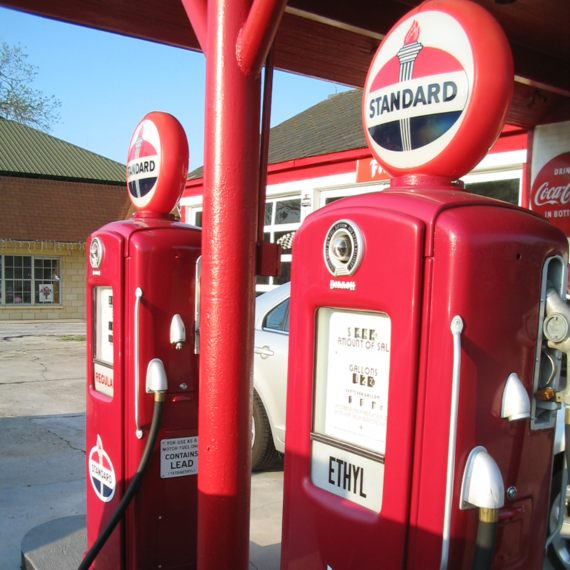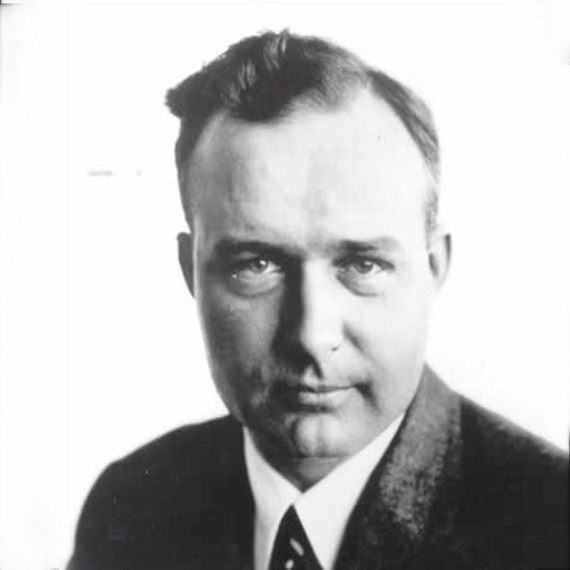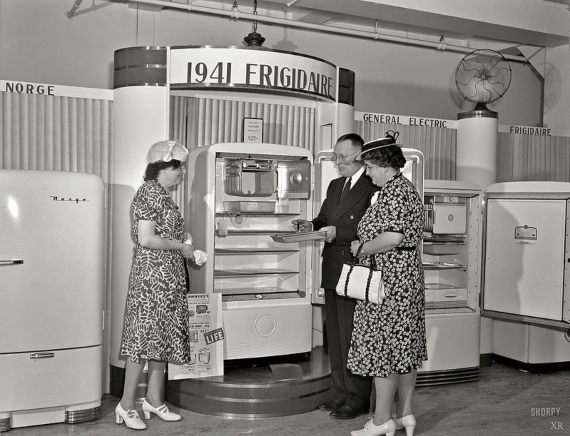There are countless inventions that have improved people’s lives and advanced civilisation, but there are also some that were initially hailed as great advances and then turned out to have a dark side. DDT, for example, is a miraculous insecticide that was found to cause serious environmental problems, or plastic packaging, which is polluting our planet from the depths of the oceans to the highest mountain peaks. However, it is difficult to surpass the magnitude of the damage caused (to both human and planetary health) by two particular inventions: leaded gasoline and chlorofluorocarbons (CFCs). Curiously, both were created by the same man, a bespectacled chemical engineer from Beaver Falls, Pennsylvania named Thomas Midgley Jr.
The gasoline of the early 20th century was of poor quality and caused engine knocking, which reduced both power and fuel efficiency and led to breakdowns. So in 1916, Charles Kettering—the inventor of the electric starter—asked one of his employees, 27-year-old Thomas Midgley (18 May 1889 – 2 November 1944) to find a petrol additive that would make car engines run more smoothly. Midgley set to work testing hundreds of different substances and eventually came up with ethanol (the same ethyl alcohol found in wines and spirits). In February 1920, Midgley filed a patent application for a mixture of alcohol and gasoline as an anti-knock fuel.
Midgley and Kettering would enthusiastically promote ethanol as the “fuel of the future,” but the production of ethanol itself could not be patented and therefore could never generate much profit. What’s more, farmers could produce ethanol easily from grain, and with Prohibition now the law in the US, more and more people were distilling their own alcohol at home. And, of course, since ethanol was also a fuel it was hated by the oil companies, with whom the fledgling automakers were developing a beneficial relationship they were loath to jeopardise.
Midgley’s dark discovery
Midgley and Kettering were by now working for General Motors, a company then under the direction of Alfred P. Sloan (considered the father of the idea of planned obsolescence), who in 1921 scrapped the plan to market ethanol-blended gasoline. However, Sloan’s strategy to compete with Ford’s popular Model-T was to build flashier cars with more powerful engines, and engine knock was still a hurdle to be overcome. So Midgley was sent back to the laboratory and told to develop an effective and inexpensive gasoline additive that could make money for General Motors.

Within just a few months, in December 1921, Midgley had found the solution: tetraethyl lead (TEL). First discovered in 1853 by the German chemist Karl Jacob Löwig, TEL had no commercial applications until Midgley found that when it was added to gasoline it eliminated engine knocking, which occurs when a cool flame ignites the fuel too early. TEL interferes with that reaction, allowing combustion to occur at the correct instant, which boosts engine compression, thereby increasing speed and fuel economy. Best of all from General Motors’ perspective, TEL was cheap to produce and its use for this purpose could be patented, generating the potential for enormous profits.
The first leaded gasoline was sold in February 1923 in Dayton (Ohio, USA) under the brand name “Ethyl”, a name that clearly evoked the discarded clean-burning ethyl alcohol, and the word “lead” was never used in any advertising or promotional material so as not to alarm the public, as the negative health effects of lead were well known.
The first deaths from TEL
The Ethyl Corporation was set up as a joint venture between the automaker General Motors and the oil company Standard Oil (now Exxon), which commissioned the chemical giant Dupont to produce an additive called “Ethyl fluid” (basically TEL and red dye), and Midgley was appointed vice-president. The company insisted that TEL was safe, but when dozens of workers began hallucinating, going insane and dying at the newly opened New Jersey manufacturing plant, several states quickly banned the substance.

Midgley, who had spent much of 1923 in Miami recovering from lead poisoning, took part in a famous press conference on 30 October 1924 to demonstrate the apparent safety of TEL. In front of reporters, he rubbed TEL on his hands and inhaled its fumes for 60 seconds, declaring that he would suffer no ill effects from doing this every day, and blamed the stricken workers for not following safety procedures. But Midgley must have known that TEL was toxic. In 1922, the Chairman of DuPont described TEL as “a colorless liquid of sweetish odor, very poisonous if absorbed through the skin, resulting in lead poisoning almost immediately.”
However, Midgley continued to turn a blind eye to the dangers of TEL, focusing instead on its purported economic benefits. In 1925, he told a meeting of scientists: “So far as science knows at the present time, tetraethyl lead is the only material available which can bring about these [anti-knock] results, which are of vital importance to the continued economic use by the general public of all automotive equipment…” And he avoided mentioning his earlier support for ethanol as an effective, clean-burning anti-knock additive.
Health effects of lead exposure
Under intense pressure from the large corporations involved, the US Surgeon General was eventually persuaded that the health effects of leaded gasoline would be minimal, especially when weighed against the much touted economic benefits. Within a few years, regulatory barriers erected by some states and health authorities were swept aside, and by 1936 Ethyl fluid was being added to 90% of the gasoline sold in the United States. In the decades that followed, leaded gasoline would become the norm throughout the world. For example, in 2000, four million cars in Mexico City were pumping some 32 tonnes of lead into the air every day.

The catastrophic effects of leaded gasoline on public health are difficult to overstate. Lead plays no role in the human body and is toxic to multiple organ systems, including the kidneys and nervous system. It is particularly harmful to children, especially their developing brains, leading to a loss of intelligence and the increased likelihood of aggressive and impulsive behaviour—effects that are permanent and untreatable. Some researchers have linked childhood lead exposure to violent crime levels in society.
Increased awareness of the negative health effects of leaded gasoline led to its progressive phasing out, a process which began in the US in the 1980s and is still ongoing (only Algeria continues to use leaded petrol today). But nearly a century of using leaded gasoline as a fuel means that huge amounts of lead remain trapped in the soil, air, water and in our bodies. According to a 1992 article in The New England Journal of Medicine, the average levels of lead in the bones of modern people are 625 times higher than those of the pre-Columbian inhabitants of North America. The World Health Organisation estimates that between 15 and 18 million children in developing countries suffer permanent brain damage due to lead poisoning, 90% of which can be attributed to leaded gasoline.
The discovery of Freon
Returning to the 1920s and Thomas Midgley, his next major invention was intended to solve a problem with General Motors refrigerators, which were becoming a popular household appliance in the Roaring Twenties. These devices sometimes leaked refrigerant gases, either sulphur dioxide (corrosive to the eyes and skin) or methyl formate (highly toxic if inhaled, and also flammable).
Midgley led the scientific team that in 1928 developed a non-toxic and non-flammable refrigerant called dichlorodifluoromethane, the very first of the chlorofluorocarbons (CFCs), which was sold under the brand name Freon-12. Ever the showman, Midgley demonstrated its effectiveness to the American Chemical Society by inhaling a lungful of the gas and blowing out a candle.

In the decades that followed, chlorofluorocarbons became ubiquitous around the world as refrigerants, propellants in aerosol cans and solvents. What Midgley could not have known at the time was that these gases would eventually tear a huge hole in the Earth’s ozone layer, which protects us from the Sun’s carcinogenic ultraviolet radiation. Although the hole caused by CFCs seems to have stabilised, the current situation is still worrying and the damage will take decades to repair itself.
Midgley’s final invention
While Midgley can be forgiven for the CFC catastrophe, the same cannot be said of tetraethyl lead, whose toxic effects were clear from the start. Thomas Midgley received many prestigious awards for these two discoveries, especially for Ethyl gasoline, as well as his 170 other patents.
In 1940, Midgley contracted polio and became paralysed and bedridden. Being a keen inventor, he devised a system of ropes and pullies that allowed others to lift and manoeuvre his body. On 2 November 1944, he became entangled in the ropes and died of strangulation at the age of 55. After the global damage caused by his two great discoveries, his final invention harmed only him.
Comments on this publication